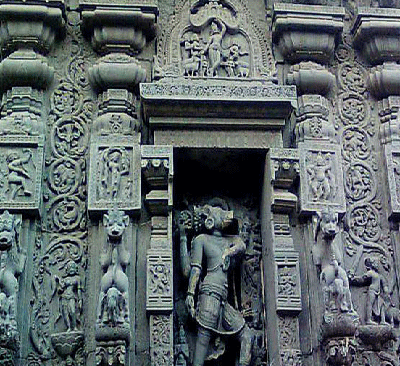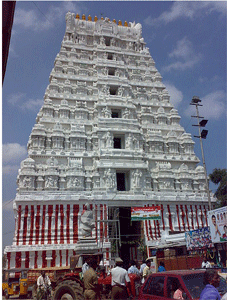Temples in South India

are the epitome of architectural excellence. The state of Andhra Pradesh is no exception. The temples in Andhra Pradesh are mostly located either on the hills or deep amidst forests. Tirumala, the abode of Venkateswara and the second richest temple in the world is located atop a group of seven hills. Owing to this reason the main deity Venkateswara is also known as 'The lord of the seven hills. The seven hills are located in the Nallamalai range of the Eastern Ghats. According to a legend, the range of hills is compared to the divine seven hooded serpent Adisesha.The legend says, the mid portion of Adisesha is considered as, Ahobilam, the abode of Narasimha. the combination of Nara (Man) and Simha ( Lion) and the tail end is considered as the famous shaivite pilgrimage Srisailam. And Tirumala is considered as the hood of Adisesha..
Venkateswara, the magnanimous
Of all the three temples mentioned above. the god of seven hills, Venkateswara gets a fabulous income through the donations given by the devotees. But the lord is so magnanimous that whatever he receives through donations from his adoring devotees, he spends towards many noble causes like maintaining a renowned university and towards the studies of ancient literature. oriental studies, engineering, medicine agriculture and many more.
Lord's two consorts
We are aware of Lord Venkateswara's two consorts. Alamelumanga and Padmavati. In the lord's abode at Tirumala one can see only Padmavati by his side. Alamelumanga stays in a different temple at Alamelumangapuram at the foot of Tirumala in Tirupati.So devotees after having Darshan of Venkateswara will go to Alamelumangapuram to have a darshan invariably.
Antiquity of the temple
The first reference about the Tirumala temple appeared during sangam period in the works of Mamulanar. In addition to this, One can see a frequent reference of Tirumala temple in the literary works of Alwars and Acharyas, Ramanujacharya is the greatest seer of this clan.Tirumala temple's Vimanam or Gopuram was constructed in the year1570AD by Tatacharya, the in charge of temple affairs of the King of Vijayanagar Venkatapati Deva Maharaja.
Ahobilam
The deity of Ahobilam is Narasimha. A contrast with the lord Venkateswara, who was like a great king. Lord Narasimha whose mission is to protect the man from the evils of tyranny like a lion. Lord Narasimha is half Nara (human) and half Simha (Lion). Narasimha is the incarnation of lord Vishnu who killed the demon king Hiranyakasipu to save his son Prahlada, a devotee of Lord Vishnu. Ahobilam is a vaishnavite temple. But it has a speciality. Ahobilam is the only vaishnavite temple where in nine incarnations of Narasimha are worshipped. All the nine incarnations of Narasimha are known as 'Nava Narasimha'.All the temples of Narasimha are located within a radius of "Five Krosas" or 10 miles, Which is why the Ahobilam is also known as "Pancha Krosa Teertham."
Prahlada Narasimha Swamy's temple is at the foot of the Ahobilam hills while the main Ahobilam temple is at the peak of the Ahobilam temple.. From this main temple, the remaining seven temples of Narasimha can be reached.
The Ahobila Math enjoys a large following. The Math's head quarters are at Ahobilam. The heads of the Math are known as "Jeers." The math was established in the year 1399 AD. Because of its large following among vaishnavite devotees, the Ahobila Math ensures a bevy of religious and spiritual congregations which make Ahobilam ever active.
Srisailam
Srisailam is located on the hills of Nallamala in the Eastern Ghats. The hills are infested with thick jungles. At the foot of the Nallamala hills, River Krishna flows. The river is very deep here. Hence the place is also known as "Patalaganga."
The presiding deity at Srisailam is Lord Mallikarjuna. Srisailam is one of the 12 Jyotirlingas. Its reference can be found in a plethora ancient texts like Mahabharata. Ancient texts say that in the abode of Srisailam Siva and Parvati stay. Brahma also stays in Srisailam along with other gods. Adi Sankara says in his Dwadasa Linga Stotra that the presiding deity of Srisailam is MallikarjunaSiva's consort Bhramaramba. Adi Sankara describes Bhramaramba as divine mother, Gayatri. Adi Sankara describes Mallikarjuna as the saviour who helps humans in overcoming the woes of attachment that is samsara.
Free access to all castes
The uniqueness of Srisailam lies in the fact the temple has privided free access to all castes even in to the Sanctum Sanctorum of the temple where any body is allowed to touch the Sivalinga. A traditional story reveals an interesting fact about the other name of Mallikarjuna, "Chenchu Mallanna".Chenchus are trbal people of Andhra Pradesh. The story tells that Lord Mallikarjuna entered in to a relationship with a Chenchu woman. Since then Lord Mallikarjuna has become popular with the name "Chenchu Mallanna." For the same reason, the tribal Chenchus have become a part of Srisailam temple affairs.
The devotees who wish to take a holy dip in the river, can avail the facilities provided in the bathing ghats.
Bhadrachalam
River Godavari travelling from its birth place Nasika Trayambakam 1500 km down to get merged with the sea, on the way it touches the feet of Sri Rama at Bhadrachalam. On the banks of the river Godavari Rama temple stands on a hillock.
The image of Sri Rama in Bhadrachalam is known as "Chaturbhuja Rama" or the Rama with four hands. This image is different fro other images of Rama in other temples.
The other names of Rama are Kodanda Rama or the Rama carrying a bow.Pattabhi Rama or the Rama depicted during his coronation.. The Rama image in Bhadrachalam depicts Rama holding bow and arrow and also Sankh and chakra, conch and discuss respectively.Sita sits on the left thigh of Sri Rama. Lakshmana stands alongside. Bharata, Satrughna and Hanuman cannot be seen. The reason for this is theBhadrachalam image depicts the Sri Rama of Dandakaranya days. That is before Sita was kidnapped.
There was an ardent devotee of Rama named Gopanna built this Rama temple at Bhadrachalam with the money collected from the people as taxes when Gopanna was serving as a Tehsildar under the regime of Tana Shah, the Qutb Shahi ruler. Because of his immense devotion to Rama, Gopanna was known as "Bhakta Ramadas", the devotee Ramadas. The sultan annoyed by the act of Ramadas jailed him for embezzling the public funds. He was jailed at Golconda fort. But according to a legend Rama appears in to the dream of Tanashah and acknowledges the receipt of the funds. Basing on this dream, Tana shah releases Ramadas. Later the ruler gifted jewels to Ramadas, with which Rama and Sita were adorned with colourful jewels.
Simhachalam
The presiding deity of Simhachalam temple is again Narasimha as at Ahobilam, half man and half lion. Narasimha kills the demon king Hiranyakasipu. According to a legend, Narasimha after killing the demon king was boiling in a fit of rage. To cool the hot Narasimha a thick layer of sandal paste was applied. Thus the practice of applying the sandal paste every day has started. The sandal paste thus applied all along the year will be removed on an auspucious day. This day is known as 'Chandana Olupu', the removal of sansal paste. On this day the devotees throng in lakhs.
The Vizianagaram royal family are the hereditary trustees of this sacred temple.
The highlights of Simhachalam are the sixteen pillared Natya Mandapa and the 96 pillared Kalyana Mandapa.
Sri Kalahasti
Sei Kalahasti is located 36 km from Tirupati.
According to a legend, a spider (Sri), a snake (Kala) and an elephant (Hasti) were worshipping a Sivalinga with sincere devotion every say. The spider has woven a net above the Sivalinga to protect it from rain and sun. The elephant used to perform abhishekam with the water fetches from the nearby river Swarnamukhi and the serpent prayed with its raised hood.
Miracles of Pilgrim tourism
They say seeing a place offers a clear and vivid picture than reading a book sitting in a library.
With the present trends in tourism, many opportunities are spread before the people in a most cost effective way to all and sundry the joy of seeing the places.
Tourism has come like a blessing from the blue to all those regions which remained backward in all respects for centuries. Many places especially districts like Srikakulam and Rayala Seema were languishing in poverty since many many years. With the arrival of Tourism in to the scenario, a new leaf was turned in the lives of the people of these backward areas.
Though there were no other facilities in these backward areas for livelihood, most of these areas were patronised by the erstwhile rulers and innmerable shrines of extraordivary artistic values were constructed. These very shrines have become a boon to the poor people after centuries. Thanks to the government of India and the tourism department of Andhra Pradesh for providing bread and butter to lakhs of people and a plethora of employment opportunities.
Thus Tourism, especially Pilgrim tourism while meeting the spiritual needs of the millions of people, created living opportunutues to many. Tourism by all means can be considered as a many faceted blessing to the local as well as to the entire people of the country.
Photos : Creative commons, wikipedia